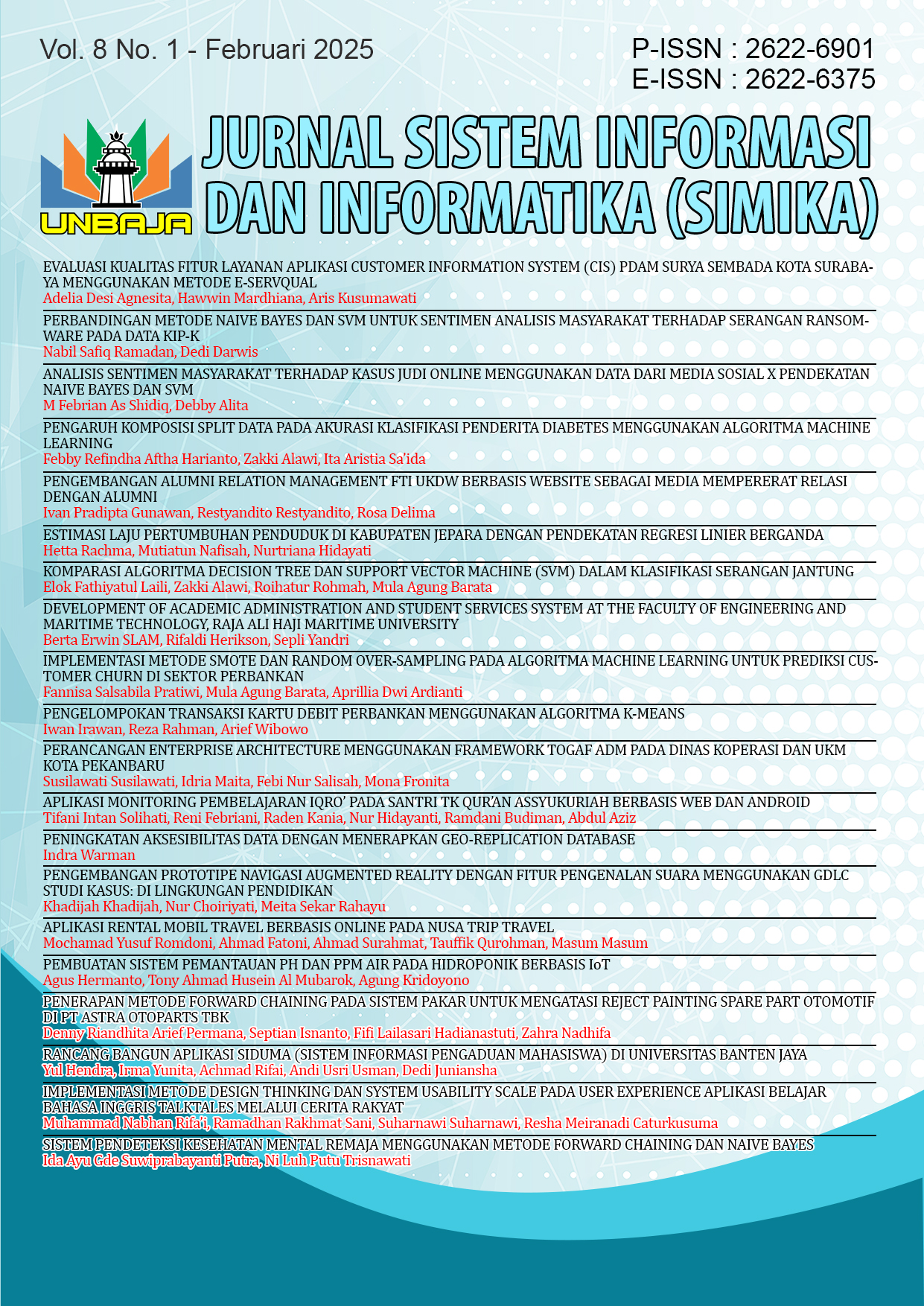PEMBUATAN SISTEM PEMANTAUAN PH DAN PPM AIR PADA HIDROPONIK BERBASIS IoT
DOI:
https://doi.org/10.47080/simika.v8i1.3446Keywords:
Hydroponics, Smart Farming, PH, TDS.Abstract
The reduction in agricultural land due to being converted into housing and urban areas means that the amount of food production is decreasing. Based on the problems above, the author offers an innovation to overcome the problem of food security through "Smart Farming". This innovation can be implemented by the community using the concept of integrated agriculture with fisheries which is easy to apply on minimal land which has not been utilized properly. However, currently There is currently no system that can monitor the pH and PPM levels of water automatically and easily. This has an impact on the poor quality of hydroponic plant production so that it cannot be sold to consumers and causes losses for this business Internet of Things (IoT) and website, this smart farming innovation was developed as a system for monitoring the condition of pH and PPM levels of water in hydroponic planting media. The development of a website-based pH and PPM monitoring system offers an innovative approach in utilizing technology to overcome the challenges of monitoring water quality effectively. By utilizing the advantages of information technology and the internet, this system can become an important solution in supporting efforts to protect the environment and sustain water resources in the future.
References
Abdullah, A., & Andres, J. (2021). Pengaruh Pemberian Pupuk Organik Cair Terhadap Pertumbuhan Tanaman Selada. Jurnal PENDAS: Pendidikan Dasar.
Fauzi, A., & Syahputra, R. A. (2021). Pengembangan Sistem Kendali pH dan PPM pada Sistem Budidaya Air Laut.
Grey, M., Bonde, Ludong, D. P., & Najoan, M. E. (2021). Smart Agricultural System in Greenhouse Based on Internet of Things for Lettuce (Lactuca Sativa L.). Jurnal Teknik Elektro Dan Komputer, 9-16.
Gunadi, & Daud, M. (2022). Rancang Bangun Sistem Kontrol Keasaman Air Kolam Ikan Menggunakan Sensor pH Berbasis Arduino. J. Fokus Elektroda (Energi List. Telekomun. Komputer, Elektron. dan Kendali), 7.
Othman, M., & Mohammed, H. (2021). Design and Development of an IoT-Based Hydroponics Monitoring and Control System. 2021 3rd International Conference on Computing. Mathematics and Engineering Technologies (iCoMET), 1-6.
Pramartaningthyas, Kumala, E., Ma'Shumah, S., & Faud, M. I. (2022). Analisis Performa Sistem Kendali Ph Dan Tds Terlarut Berbasis Internet Of Things Pada Sistem Hidroponik Dft. Jurnal RESISTOR (Rekayasa Sistem Komputer), 5, 1-9. doi:10.31598/jurnalresistor.v5i1.954.
Sharma, R., & Singh, M. (2021). IoT-Based Water Quality Monitoring System Using pH and TDS Sensors. International Journal of Scientific Research in Computer Science, Engineering and Information Technology.
Siswidiyanto, Ahmad, M., Diah, W., & Eko, H. (2020). Sistem Informasi Penyewaan Rumah Kontrakan Berbasis Web Dengan. Jurnal Publikasi Ilmiah Bidang Teknologi Informasi dan Komunikasi.
Sotyohadi, Dewa, W. S., & Somawirata, I. K. (2020). Perancangan Pengatur Kandungan TDS dan PH pada Larutan Nutrisi Hidroponik Menggunakan Metode Fuzzy Logic. ALINIER J. Artif. Intell. Appl.
Syarifudin, A. A., Hutahean, A. D., Widiawira, B. Y., Rahmania, M. M., Panjaitan, M. A., Priyankha, M. A., & Taufikurrahman. (2022). Pelatihan Budidaya Kangkung dengan Menggunakan Sistem Hidroponik di Desa Banjarsari. Jurnal pengabdian Kepada Masyarakat.
Zhang, W., & Liu, X. (2020). IoT-based Water Quality Monitoring System using pH and TDS Sensors. IEEE Transactions on Industrial Informatics.












